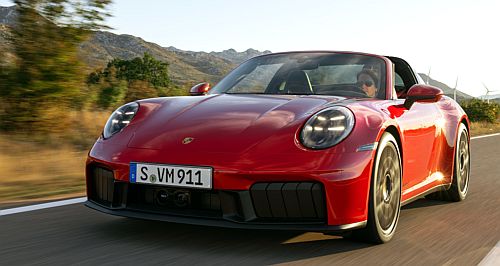Porsche 911 T-Hybrid introduces dual hybrid tech

PORSCHE has demonstrated its engineering nous in the upgraded petrol/electric hybrid Carrera GTS and to a lesser extent the twin turbo 911 Carrera models, the former a tech tour-de-force featuring an electric motor within the turbocharger itself that contributes to system power and reduces turbo lag in addition to an integrated electric traction motor in the transmission.
The ‘new’ 911 is priced from $280,500 plus on-road costs and is expected in Australian showrooms in the first quarter of 2025. Pricing of the range increases by as much as $31,300 (see table below for details).
Other model highlights include a revamped design, better (active) aerodynamics, a fresh interior with digital cockpit, upgraded standard equipment and expanded connectivity.
The 911 Carrera is available in Coupe and Cabriolet configuration while the GTS adds a Carrera 4 to the RWD Coupe and Cabrio variants along with a Targa AWD model.
But the focus is on the clever T-Hybrid system that allows Porsche to run a single turbocharger instead of two on its newly developed 3.6-litre flat six-cylinder engine in the GTS model for gains across the board in efficiency including performance.
The new 911 Carrera GTS is the first street-legal 911 super-lightweight performance hybrid endowing the Coupe model with a zero to 100km/h sprint in 3.0 seconds and a top speed of 312km/h for the track.
As already mentioned, the T-Hybrid system has an electric motor in the exhaust gas turbocharger positioned between the compressor and turbine wheel that Porsche says, “instantaneously brings the turbocharger up to speed”.
It immediately builds up boost pressure eliminating turbo lag and functions as a generator cranking up to 11kW of electric power into the powertrain, energy extracted from the exhaust gas flow. Because of its instantaneous boost, the waste gate-free electric turbo allows the use of only one unit instead of the previous two turbos.
Additional to this, the powertrain also includes a 40kW/150Nm permanent magnet synchronous motor integrated into the new eight-speed dual-clutch transmission (PDK).
Both electric motors are coupled to a lightweight and compact high-voltage battery corresponding in size and weight to a conventional 12-volt starter battery and capable of storing up to 1.9kWh of energy operating on 400V.
Porsche has installed a lightweight lithium-ion battery for the 12V on-board electrical system.
The high-voltage system allows the air-conditioning compressor to be driven electrically and the belt drive to be omitted reducing overall engine size to create space above for the pulse inverter and DC-DC converter.
The 3.6-litre flat six engine is based on Porsche’s current 3.0-litre boxer with an enlarged bore to 97mm and increased stroke to 81mm.
Porsche’s VarioCam camshaft control and a valve control with rocker arms is used to maximise efficiency so much so that even without electrical assistance, the boxer engine delivers 357kW and 570 Nm of torque with the total system output rated at 398kW and 610Nm, a power increase over its predecessor of 45kW.
The 911 Carrera will also be available concurrent with the GTS and is powered by a lightly modified 3.0-litre twin-turbo boxer six pot engine that is more powerful than its predecessors rated at 290kW and 450Nm. It has a larger intercooler and uses the twin turbos from the previous GTS model.
The Carrera Coupe goes from 0 to 100km/h in 4.1 seconds (3.9 seconds with the Sport Chrono package) and has a top speed of 294km/h for the track.
In addition to the T-Hybrid tech, the 911 GTS scores optimised suspension and active aerodynamics with, for the first time, rear-axle steering as standard. The sports suspension with a variable damper system (PASM) and a ride height lowered by 10mm provide sharper handling.
Seven wheel choices are available on the new 911 Carrera from 19-/20-inch or 20-/21-inch designs with an option for carbon blade wheels that reduce the drag coefficient and increase efficiency.
The GTS models roll on 11.5-inch wide 21-inch wheels with 315/30 ZR 21 tyres at the rear as standard and 245/35 ZR 20 tyres on 8.5- inch wide 20-inch wheels at the front.
Model-specific exhaust systems are elegantly integrated into the striking diffuser fins. A sports exhaust system is optionally available for the 911 Carrera models. The 911 Carrera GTS models come standard with a GTS-specific sports exhaust system.
Both model variants are equipped with Porsche Doppelkupplung (PDK dual clutch transmission) as standard.
According to Porsche info’ its engineers used knowledge gained from motor racing as the basis for designing the hybrid system.
“We developed and tested a wide variety of ideas and approaches to arrive at the hybrid system that would suit the 911 perfectly,” said Porsche 911 and 718 model line vice president Frank Moser.
“The result is a unique drive that fits into the overall concept of the 911 and significantly enhances its performance.”
Porsche CEO Oliver Blume said, “With the relaunch of this iconic model, Porsche has modernised four of its six model lines in just a few months: Panamera, Taycan, Macan and 911.”
“Our product portfolio is younger than ever and highly attractive offering our customers even more customisation options and exclusive experiences.”
2025 Porsche 911 Carrera and Carrera GTS pricing*:
|
Carrera Coupe (a) |
$280,500 |
(+$2700) |
|
Carrera Cabriolet (a) |
$303,800 |
(+$5100) |
|
Carrera GTS Coupe (a) |
$381,200 |
(+$27,500) |
|
Carrera 4 GTS Coupe (a) |
$401,300 |
(+$28,300) |
|
Carrera GTS Cabriolet (a) |
$417,400 |
(+$30,500) |
|
Carrera 4 GTS Cabriolet (a) |
$437,900 |
(+$31,300) |
|
Targa 4 GTS (a) |
$437,900 |
(+$31,300) |
*Pricing excludes on-road costs.